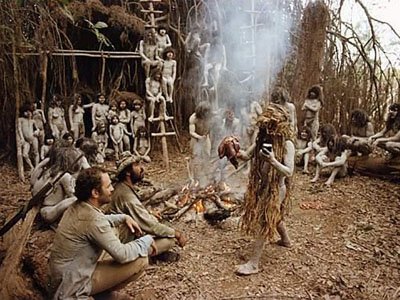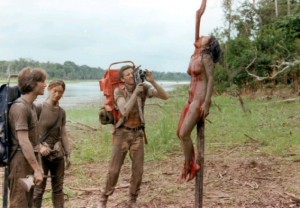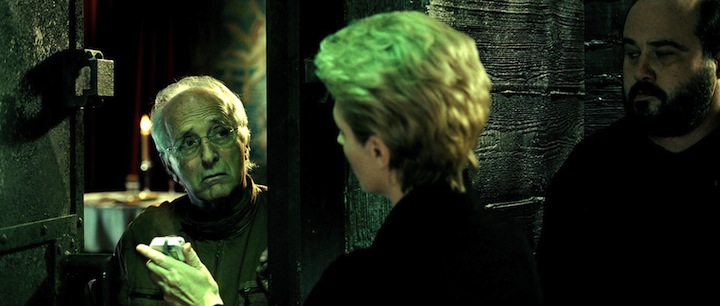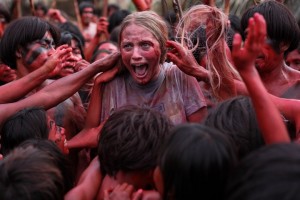 The Ninth Annual Buried Alive Film Festival; Saturday, Nov. 22, 3:00 p.m. – 12:30 a.m.; Sunday, Nov. 23, 1:00 p.m. – 10:30 p.m.; Fabrefaction Theatre; Tickets $50 (all access, both days), $10 per programming block, available here. Opening night party Friday, Nov. 21, 8:00 p.m. – 11:59 p.m. @ Joystick Game Bar.
The Ninth Annual Buried Alive Film Festival; Saturday, Nov. 22, 3:00 p.m. – 12:30 a.m.; Sunday, Nov. 23, 1:00 p.m. – 10:30 p.m.; Fabrefaction Theatre; Tickets $50 (all access, both days), $10 per programming block, available here. Opening night party Friday, Nov. 21, 8:00 p.m. – 11:59 p.m. @ Joystick Game Bar.
By Aleck Bennett
Contributing Writer
Need a reason to be bloody thankful this month? Well, here’s something to make your twisted Thanksgiving complete: the notorious Buried Alive Film Festival (BAFF) is back for its ninth reincarnation! Atlanta’s favorite, longest-running horror film festival will be at Fabrefaction Theatre on November 22 and 23. This year, Festival Director (and ATLRetro Kool Kat of the Week) Blake Myers and the Buried Alive team have exhumed three features and 50 short films—almost 20 hours of programming including nine American premieres and three world premieres! With a host of filmmakers in attendance, this year promises to be a glorious celebration of horror, further sealing Atlanta’s place as the horror capitol of the nation!
 The weekend kicks off in style with an opening night party at Joystick Game Bar on Friday, Nov. 21, from 8 p.m. to midnight. Come on out and meet the filmmakers behind this year’s fearsome feast of fright! But pace yourself, because Saturday’s programming starts off at 3 p.m. with Shorts Program 1: Tentacles, Kidney Stones and Cannibalism. This exploration of the darkly comic and disturbingly surreal spans the globe, from here to Turkey and back again. Highlights include the post-apocalyptic doom of THE LAST HALLOWEEN, a disorienting trip with four Turkish policemen into the gaping maw of Hell in the highly acclaimed (by no less than Eli Roth and Richard Stanley) BASKIN, the hilariously gory DEAD ALIVE-meets-“Love Potion Number 9” French splatstick of SPEED FUCKING and the world premiere of local director Jay Halloway’s subterranean terror UNDERLOCK.
The weekend kicks off in style with an opening night party at Joystick Game Bar on Friday, Nov. 21, from 8 p.m. to midnight. Come on out and meet the filmmakers behind this year’s fearsome feast of fright! But pace yourself, because Saturday’s programming starts off at 3 p.m. with Shorts Program 1: Tentacles, Kidney Stones and Cannibalism. This exploration of the darkly comic and disturbingly surreal spans the globe, from here to Turkey and back again. Highlights include the post-apocalyptic doom of THE LAST HALLOWEEN, a disorienting trip with four Turkish policemen into the gaping maw of Hell in the highly acclaimed (by no less than Eli Roth and Richard Stanley) BASKIN, the hilariously gory DEAD ALIVE-meets-“Love Potion Number 9” French splatstick of SPEED FUCKING and the world premiere of local director Jay Halloway’s subterranean terror UNDERLOCK.
 BAFF reconvenes at 5 p.m. for Shorts Program 2: Some Real, Some Fake, All Fucked Up. Taking a more realistic turn than the previous program, these shorts focus on the horrors of the here-and-now, ranging from the twisted psychosis of EXTREME PINOCCHIO, also French, to the provocative documentary GLASS EYES OF LOCUST BAYOU. The standouts in this category—along with those previously mentioned—include the American premieres of the funerary revenge short PARA NOCHES DE INSOMNIO and the expertly executed murder of RELLIK.
BAFF reconvenes at 5 p.m. for Shorts Program 2: Some Real, Some Fake, All Fucked Up. Taking a more realistic turn than the previous program, these shorts focus on the horrors of the here-and-now, ranging from the twisted psychosis of EXTREME PINOCCHIO, also French, to the provocative documentary GLASS EYES OF LOCUST BAYOU. The standouts in this category—along with those previously mentioned—include the American premieres of the funerary revenge short PARA NOCHES DE INSOMNIO and the expertly executed murder of RELLIK.
After a short break, we’re back at 7 p.m. to ponder love, desire and the meaning of “togetherness” in Shorts Program 3: Healthy Relationships. Whether living or dead, functional or dysfunctional, human or inhuman, all of the permutations of companionship are on display in this variety of shorts. Two noteworthy local entries make debuts during this program—Brandon Delaney’s first-person dialogue MY BOYFRIEND’S BAG in its world premiere, and local filmmaker James Sizemore’s Satanic opus GOAT WITCH which hits Georgia screens for the first time. Also getting American premieres are two UK shorts: SKIN, which turns the hostage/captor relationship on its head, and the unsettling physical manifestation of a deteriorating relationship of SPLIT. Add in the Norwegian sadistic ANGST, PISS AND SHIT and the fetish-laden morgue visit of I AM MONSTER, and you’ve got an evening full of romance. Well, in a manner of speaking anyway.
 Night falls with the festival’s first feature program at 9 p.m. This kicks off with two shorts: the tortured texts of M IS FOR MOBILE and the Georgia premiere of Patrick Longstreth’s Tybee Island-lensed giant monster rampage HELLYFISH. That’s followed by the world premiere of ATLRetro Kool Kat Eddie Ray’s long-awaited second entry in his epically comic tale of devil worship, rock ‘n’ roll warfare and government conspiracies, SATANIC PANIC 2: BATTLE OF THE BANDS!
Night falls with the festival’s first feature program at 9 p.m. This kicks off with two shorts: the tortured texts of M IS FOR MOBILE and the Georgia premiere of Patrick Longstreth’s Tybee Island-lensed giant monster rampage HELLYFISH. That’s followed by the world premiere of ATLRetro Kool Kat Eddie Ray’s long-awaited second entry in his epically comic tale of devil worship, rock ‘n’ roll warfare and government conspiracies, SATANIC PANIC 2: BATTLE OF THE BANDS!
As the festival heads into the wee hours at 11 p.m., the second feature program of the night is Andres Torres’ horrifying journey through the seedy underbelly of the New York art world and into the twisted mind of a lonely hot dog vendor, BAG BOY LOVER BOY. Driven by killer performances and an escalating sense of discomfort, this film—which meets us at the cross-section of William Lustig’s MANIAC and Roger Corman’s A BUCKET OF BLOOD—is well worth staying up for. The evening closes with a French short film that explores the unease lurking under the comforts of HOME.
 Feeling rested? Slept well after the horrors of the night before? Already got your brunch on and ready to go? Good! Because Buried Alive rises again Sunday at 1 p.m. with Shorts Program 4: Scary Animal Monsters from Outer Space at Your Service. As the program’s title suggests, the selection here is widely varied. The subjects range from the whimsical DEAD HEARTS to the vengeful water spirits of SHUI GUI, from a killer’s paranoia in SEMBLANCE to the wild Australian pathogenic zombie-kangaroo horror of WATERBORNE. Receiving its American premiere is the hilarious BUDGET CUTS, an instructional short on how to maintain your serial killer lifestyle when time and money are tight. Also making its American debut is THE BEAR FAMILY SECRET, a stark and powerful tale of homebound human horror set during the Brazilian dictatorship of 1970. And on the local front, Dayna Noffke unveils her latest work, RECOMPENSE, in its world premiere! It’s a twisty little gem in the EC Comics tradition, in which a prisoner finds out just how much his freedom will cost.
Feeling rested? Slept well after the horrors of the night before? Already got your brunch on and ready to go? Good! Because Buried Alive rises again Sunday at 1 p.m. with Shorts Program 4: Scary Animal Monsters from Outer Space at Your Service. As the program’s title suggests, the selection here is widely varied. The subjects range from the whimsical DEAD HEARTS to the vengeful water spirits of SHUI GUI, from a killer’s paranoia in SEMBLANCE to the wild Australian pathogenic zombie-kangaroo horror of WATERBORNE. Receiving its American premiere is the hilarious BUDGET CUTS, an instructional short on how to maintain your serial killer lifestyle when time and money are tight. Also making its American debut is THE BEAR FAMILY SECRET, a stark and powerful tale of homebound human horror set during the Brazilian dictatorship of 1970. And on the local front, Dayna Noffke unveils her latest work, RECOMPENSE, in its world premiere! It’s a twisty little gem in the EC Comics tradition, in which a prisoner finds out just how much his freedom will cost.
 The first feature program of the day follows at 3 p.m. The supporting short, DONE IN, follows a man’s reminiscences as he pens his farewell to this world. In the featured slot is the American premiere of veteran Japanese director Hisayasu Satô’s HANA-DAMA: THE ORIGINS. A visually explosive exploration of the torment a young girl faces at school and at home, the film takes a novel path in its tale of revenge: a bullied student becomes possessed by a flower, the Hana-Dama, which makes manifest the secret desires of all those who have caused her pain.
The first feature program of the day follows at 3 p.m. The supporting short, DONE IN, follows a man’s reminiscences as he pens his farewell to this world. In the featured slot is the American premiere of veteran Japanese director Hisayasu Satô’s HANA-DAMA: THE ORIGINS. A visually explosive exploration of the torment a young girl faces at school and at home, the film takes a novel path in its tale of revenge: a bullied student becomes possessed by a flower, the Hana-Dama, which makes manifest the secret desires of all those who have caused her pain.
At 5 p.m., we leave the realm of the photorealistic behind and enter Drawn and Quartered: The Animation Program. This series of shorts is bookended by the works of Edgar Allan Poe, in adaptations from Moonbot Studios: visually stunning old-school animation adaptations of THE RAVEN and THE CASK OF AMONTILLADO. In between, the festival is serving up two tales of teddy bear terror in MEAN TEDDIES and UNICORN BLOOD, the final evolution of life rising from a wasteland in Germany’s OMEGA, a wacky SHINING-inspired tale of wacky sibling rivalry and murder in the witty THE LAST RESORT and a knowing tale about the importance of choosing the right doctor in EYE IN TUNA CARE. On the local front, Amanda Smith  presents a disturbing stop-motion account of a romantic dinner gone horribly awry in TRUE LOVE, and Wally Chung presents a cautionary warning about conformity and discrimination in TALL EVIL. One entry that stands out, however, is Finnish director Tomi Malkki’s FIST OF FIRE (aka TULIKOURA), the surprisingly touching story of a dying death metal drummer, his faithful dog and his post-mortem journey. Maybe my love of Finnish metal is showing through, but the short is moving and ghoulishly funny in addition to being totally and brutally metal. Malkki also will be in attendance, all the way from Finland, to talk about his film.
presents a disturbing stop-motion account of a romantic dinner gone horribly awry in TRUE LOVE, and Wally Chung presents a cautionary warning about conformity and discrimination in TALL EVIL. One entry that stands out, however, is Finnish director Tomi Malkki’s FIST OF FIRE (aka TULIKOURA), the surprisingly touching story of a dying death metal drummer, his faithful dog and his post-mortem journey. Maybe my love of Finnish metal is showing through, but the short is moving and ghoulishly funny in addition to being totally and brutally metal. Malkki also will be in attendance, all the way from Finland, to talk about his film.
The second feature program of the day starts at 7 p.m. with another local offering: the Georgia premiere of Robert Bryce Milburn’s AMERICAN HELL, a short glimpse of the nightmare of isolation a family confronts when they are subject to a home invasion. That provides a perfect lead-in to the feature attraction, Adam Petke and  Sean Blau’s THE SUNDERLAND EXPERIMENT, quite simply one of the most gob-smackingly original films this festival has to offer. This quietly building piece of cosmic horror is set in the isolated, fenced-off desert town of Sunderland. Something identifying itself as an “angel” has converted the town into a strange simulacrum of everyday society, and the adults into its surrogates. The children can either accept the angel’s “blessing” and become like their parents, or become the “fallen” and are left to fend for themselves in the wasteland surrounding the town’s border. One of the young men, David, is destined to learn the truth about his family, the town, and the true nature of the angel that controls their lives. It’s a stunning piece of work.
Sean Blau’s THE SUNDERLAND EXPERIMENT, quite simply one of the most gob-smackingly original films this festival has to offer. This quietly building piece of cosmic horror is set in the isolated, fenced-off desert town of Sunderland. Something identifying itself as an “angel” has converted the town into a strange simulacrum of everyday society, and the adults into its surrogates. The children can either accept the angel’s “blessing” and become like their parents, or become the “fallen” and are left to fend for themselves in the wasteland surrounding the town’s border. One of the young men, David, is destined to learn the truth about his family, the town, and the true nature of the angel that controls their lives. It’s a stunning piece of work.
The festival closes on a holly jolly note at 9 p.m. with Shorts Program 5: A Very Special Zombie Christmas. MR. DENTONN opens the proceedings with the fairy tale-esque story of a sinister visitor that enters homes through mirrors and steals children’s souls. Afterward, we take a peek into the Troma-esque comedy of CHRISTMAS EVE PET MASSACRE, where the world’s worst family finds that their pets are more than glad to bite the hands that feed them. Then it’s off to Latin America for ZUGAR ZOMBIE—a potent cocktail of political corruption, the undead and grand irony. Finally, we wrap things up at the festival  much like we started: with a delicious look at Halloween. This time, it’s Jonathan Rej and Shane Morton’s ATLANTA ZOMBIE APOCALYPSE. A group of rowdy youths (the best kind) find themselves trapped in a cheesy haunted house when the zombie uprising breaks out. Is it all part of Professor Morté’s spook show? Or is it all too real? A labor of love from pretty much everyone involved with the dearly-departed Halloween haunt of the same name and the Atlanta horror film scene, it’s a gut-busting and gut-munching RETURN OF THE LIVING DEAD-styled throwback to the heyday of ‘80s zombie horror. Stick around afterwards to find out the Festival winners (Disclosure: ATLRetro Publisher/Editor Anya Martin is a judge). It’s also the perfect way to close yet another fantastic run of the Buried Alive Film Festival.
much like we started: with a delicious look at Halloween. This time, it’s Jonathan Rej and Shane Morton’s ATLANTA ZOMBIE APOCALYPSE. A group of rowdy youths (the best kind) find themselves trapped in a cheesy haunted house when the zombie uprising breaks out. Is it all part of Professor Morté’s spook show? Or is it all too real? A labor of love from pretty much everyone involved with the dearly-departed Halloween haunt of the same name and the Atlanta horror film scene, it’s a gut-busting and gut-munching RETURN OF THE LIVING DEAD-styled throwback to the heyday of ‘80s zombie horror. Stick around afterwards to find out the Festival winners (Disclosure: ATLRetro Publisher/Editor Anya Martin is a judge). It’s also the perfect way to close yet another fantastic run of the Buried Alive Film Festival.
Aleck Bennett is a writer, blogger, pug warden, pop culture enthusiast, raconteur and bon vivant from the greater Atlanta area. Visit his blog at doctorsardonicus.wordpress.com





